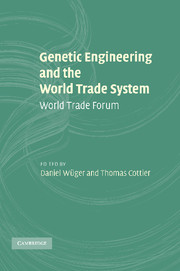Book contents
- Frontmatter
- Contents
- List of contributors
- List of abbreviations
- PART I Introduction and systemic issues
- PART II Intellectual property and gene technology: issues at stake and possible options
- PART III Food security, trade and agricultural production with genetically modified organisms
- PART IV Food safety, international trade and biotechnology
- 10 Trade, environment and biotechnology: on coexistence and coherence
- 11 Risk regulation, precaution and trade
- PART V Medical research, cloning and international trade
- Index
10 - Trade, environment and biotechnology: on coexistence and coherence
Published online by Cambridge University Press: 06 October 2009
- Frontmatter
- Contents
- List of contributors
- List of abbreviations
- PART I Introduction and systemic issues
- PART II Intellectual property and gene technology: issues at stake and possible options
- PART III Food security, trade and agricultural production with genetically modified organisms
- PART IV Food safety, international trade and biotechnology
- 10 Trade, environment and biotechnology: on coexistence and coherence
- 11 Risk regulation, precaution and trade
- PART V Medical research, cloning and international trade
- Index
Summary
Introduction
The phenomenon of normative proliferation and its consequences have attracted much attention in recent years. The phenomenon is variously described as ‘fragmentation’, ‘diversity’, ‘cacophony’, ‘inter-connected islands’, ‘regime-collisions’ or ‘internormativity’. In this context, there are calls for coherence, or at least for a peaceful coexistence among the various sets of norms. The need for the ‘strengthening’ of a coherent and interactive legal framework is particularly pronounced in the field of the trade and environment relationship.
It is a need for ‘strengthening’, rather than a need for ‘building’, because there is already, and prima facie, a certain coherence among WTO Agreements and multilateral environmental agreements (MEAs). In both cases, the objective of sustainable development is explicitly stated. In addition, WTO law – and especially the General Agreement on Tariffs and Trade (GATT), the Agreement on Technical Barriers to Trade (TBT) and the Agreement on Sanitary and Phytosanitary Measures (SPS) – allows Member States to adopt trade-restrictive measures in order to protect the environment as long as they respect the principles of non-discrimination and of proportionality (objective of minimising negative trade effects). Article XX of GATT 1994 allows trade measures which protect human, animal or plant life or health, and which relate to the conservation of exhaustible natural resources. The TBT Agreement also foresees the domestic implementation of voluntary standards and mandatory technical regulations for essentially the same objectives.
- Type
- Chapter
- Information
- Genetic Engineering and the World Trade SystemWorld Trade Forum, pp. 205 - 245Publisher: Cambridge University PressPrint publication year: 2008
- 1
- Cited by



